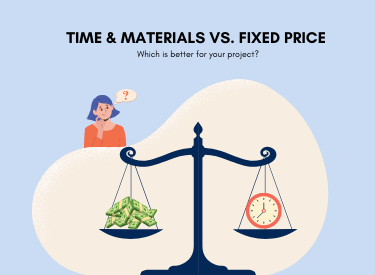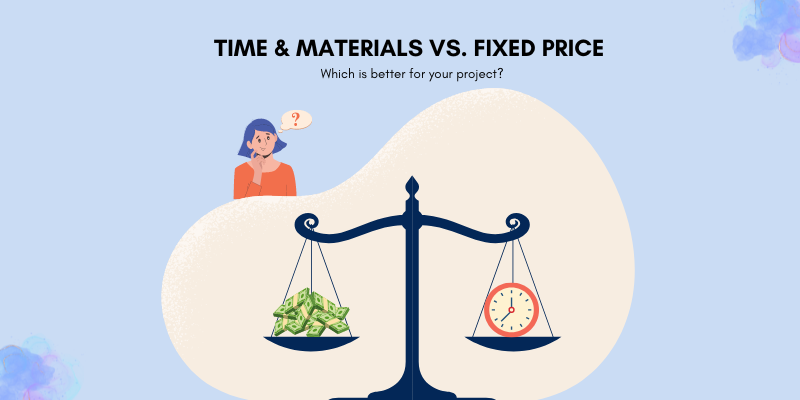Fixed Price vs. Time & Materials: Which is better?

When outsourcing software development, choosing Fixed Price and Time & Materials (T&M) payment models isn’t just about economic benefits and risks. It greatly impacts how you work with a vendor and how the project goes.
I don’t think there’s one right answer to the question of which model is better because it depends on your project. I’ve put the information we usually discuss with Bestarion’s clients about the outsourcing payment model in the table below. You can use it in your project or decide what to do with it.
Fixed price model
What does “Fixed-Price model” mean?
A Fixed-Price Collaboration Model operates just as it sounds. You give the company doing the work a lump sum in exchange for specific results. It’s one of the most common ways to work together because companies feel safe and secure with a fixed-price contract. They have a set budget to ensure the project won’t cost more. This cooperation model sounds good for a business that needs to plan its budget and costs carefully.
Also, a deadline is “set in stone,” by which time the client is “guaranteed” to have the finished product. With a detailed plan that includes goals and major steps, they can easily track the progress of the project. The client doesn’t need to keep an eye on the project, so everything sounds clear and easy to understand. A Fixed-Price model might be what you need if your project is small, has clear features, and there isn’t much chance that things will change.
Advantages of Fixed Price Model
Budget and timeline transparency . From the beginning, you know how much you’ll have to pay and when the project will be done. If you have a strict budget and/or deadlines, a fixed-price contract can help you plan (say, in governmental projects).
Clarity around project outcomes. You have a detailed understanding of what your software will be capable of right from the start of the project, so you have time to make it a thought-out part of your business strategy. For example, estimate its impact on business processes, prepare a plan for software adoption, and integrate it into your employees’ workflows.
Little management attempts. Your input is at its peak during the planning phase. After the project commences, you can free up resources and reduce your engagement to scope compliance checks, which are simple to conduct with accurate specifications and schedules.
Disadvantages of Fixed Price Model
Slow project launch. A very detailed software specification is required for a fixed-price project. It can take several weeks or even months to make one, depending on how complicated the software is.
Changes are hard to make or almost impossible. Any changes you want to make later in the project, like ones caused by changes in the market or your business plan, need to be negotiated and paid for separately, which can slow down development.
Not being able to try the software before it is delivered. Although you manage the progress of the software development team, you cannot see the software in action until the last stage of development to ensure it meets all of your requirements. And fixing any anomalies at the final stage would be a costly process. Sometimes, a lengthy adjustment to the testing procedure can result in an entirely new project.
When can you safely choose a Fixed-Price contract?
- It’s a small or medium-sized project or a Minimum Viable Product (MVP).
- You’ve told the developers what you want and expect from them. By “clearly,” we mean that you can describe the user’s path and have written user stories before.
- The needs of the project won’t change.
- You don’t need or have time to get together with the development team.
- There’s not much chance of developing problems, so you can give the developers all power.
- You only have a small amount of money to spend on the project, or you need to get the budget approved first.
- You don’t care about how long it takes, only what gets done. This means that sometimes the project is done faster, but you still get charged the same amount.
Time and material (T&M) model
What does “Time & Material Model” mean?
A Time & Materials contract means payment for the effort based on daily or hourly rates. You will be paying for the amount of work, the hours and days that developers spend to complete your software, web, or app development project
Projects that use the time and materials model are geared toward Agile. A vendor will usually send you invoices and reports monthly to give you a full picture of the work done.
Advantages of Time & Material Model
Adaptability. You and a vendor agree on a project roadmap and milestones, but the scope of work is still flexible and can change as you see fit. You can make smart choices about the next steps of development by looking at the results of the last ones (feedback from end-users) and analyzing the latest market trends.
Start up a project quickly. Since a software specification doesn’t need to be as detailed as it would be for a fixed-price project, the planning stage is shorter, and you can get to work on developing software sooner.
Continuous quality assurance. Continuous testing is done alongside T&M-based development to ensure that requested changes and new features have been added. This way, software gets better and better for multiple project iterations.
Disdvantages of Time & Material Model
The budget and deadlines are unclear. the final price may be more than the budgeted amount, and the same goes for when they come out. One way to make things clearer is to track a team’s progress with key performance indicators (KPIs) that help predict and plan the scope of work more accurately over time (such KPIs are team velocity, lead time, and cycle time). For more information, you can read our CTO’s article on the project health KPIs.
More work has been put into management. Even though the T&M model lets you control the deliverables, you still need to ensure you have enough resources to work with a vendor and give quick feedback to keep the development pace steady.
When is a T&M contract the right choice?
- It’s hard or will take a long time.
- You only have a general idea of the product and how it works.
- Most likely, the needs or wants will change.
- You want to be in charge of the whole process of making and improving products.
- You need as much freedom as possible.
- You only want to pay for the time that was spent. Compared to a fixed-price model, this is the most cost-effective way to handle long-term projects with changing scopes.
So, Which is Best? Time and Materials or Fixed Price Contracts?
In the end, the choice between Fixed Price and Time & Material pricing models comes down to the IT needs of your business. The best way to figure out which one is right for you is to ask yourself the questions below:
Do you know what you need exactly?
For fixed-price contracts to work, we need to know exactly what you want to be done so we can give you a good estimate. If you don’t know how big your project is, you can’t expect us to come up with a bid that will work. Under a T&M Contract, it might be in your best interest to have a “discovery” period until everyone has a better idea of what you want. At that point, you can switch to a fixed pricing model if you want to.
What Is Risk Management Worth To You?
Fixed-Price Contracts give you the peace of mind that the price won’t go up. That is easy to plan for in your budget, but you may have to pay more for the ease. For example, we might give a job a fixed price of $300,000 but only a T&M price of $250,000. The reason is simple: we need to overshoot on a fixed rate if something unexpected goes wrong, but T&M takes care of that possibility.
How Important Is Flexibility To You?
If you want to be able to get IT help whenever you need it, you can do that with a T&M pricing structure. Since we charge you by the hour, you have a lot of say over what we do on your money. With a T&M model, it is much easier to change what you want on the spot since nothing is set in stone in the contract.
With fixed-price contracts, we usually work alone to get the desired results, so you lose some control over the process. Changing anything would require renegotiating and a few extra fees, making the arrangement less flexible. Fixed pricing structures can be more flexible in some ways, but generally, T&M arrangements give you much more freedom.
A Quick Review: Fixed Price vs.Time and Materials
To sum up, Fixed Price models are easy to budget for and reduce risk, but you have less freedom with them. Time & Materials contracts are much more flexible and less expensive if everything goes as planned. Still, they are riskier if your needs exceed what was quoted.
For the Best Value Pricing for IT Services – Talk to Bestarion’s Specialist Today
At Bestarion, we understand that maximizing your IT services’ value is your company’s top priority. Our high level of experience and streamlined processes allow us to offer affordable customized rates to meet your individual needs.
For further information about our services and the potential benefits of working with an outsourced development provider, please feel free to contact us.

